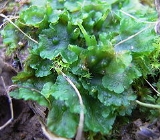
Phaeoceros
Encyclopedia
Phaeoceros is a genus
of hornwort
s in the family
Notothyladaceae
. The genus is global in its distribution. Its name means 'yellow horn', and refers to the characteristic yellow spore
s that the plants produce in the horn-shaped sporophyte
. The genus Phaeoceros was first recognized in 1951 by Johannes Max Proskauer
. The type species is Phaeoceros laevis
. The genus is distinguished by having yellow spores, different chloroplast
structure, relatively less frilliness of the thallus
when compared to Anthoceros, and a relative lack of internal cavities in Phaeoceros.
The yellow color of the spores is the easiest way to distinguish Phaeoceros from the common genus Anthoceros
, which produces spores that are dark brown to black. Phaeoceros is often confused with Anthoceros, and dried plants are particularly difficult to distinguish in, but the two genera can always be recognized, when fertile and mature, by the spores. When sterile, the distinguishing characteristic is the absence of lacunae (gaps within the tissue) within the thallus, which in Anthoceros are large and numerous.
Genus
In biology, a genus is a low-level taxonomic rank used in the biological classification of living and fossil organisms, which is an example of definition by genus and differentia...
of hornwort
Hornwort
Hornworts are a group of bryophytes, or non-vascular plants, comprising the division Anthocerotophyta. The common name refers to the elongated horn-like structure, which is the sporophyte. The flattened, green plant body of a hornwort is the gametophyte plant.Hornworts may be found worldwide,...
s in the family
Family (biology)
In biological classification, family is* a taxonomic rank. Other well-known ranks are life, domain, kingdom, phylum, class, order, genus, and species, with family fitting between order and genus. As for the other well-known ranks, there is the option of an immediately lower rank, indicated by the...
Notothyladaceae
Notothyladaceae
The Notothyladaceae is the only family of hornworts in the order Notothyladales....
. The genus is global in its distribution. Its name means 'yellow horn', and refers to the characteristic yellow spore
Spore
In biology, a spore is a reproductive structure that is adapted for dispersal and surviving for extended periods of time in unfavorable conditions. Spores form part of the life cycles of many bacteria, plants, algae, fungi and some protozoa. According to scientist Dr...
s that the plants produce in the horn-shaped sporophyte
Sporophyte
All land plants, and some algae, have life cycles in which a haploid gametophyte generation alternates with a diploid sporophyte, the generation of a plant or algae that has a double set of chromosomes. A multicellular sporophyte generation or phase is present in the life cycle of all land plants...
. The genus Phaeoceros was first recognized in 1951 by Johannes Max Proskauer
Johannes Max Proskauer
Johannes Max Proskauer was born in Göttingen, Germany. He attended the University of London, which awarded him a B.Sc. in 1944, a Ph.D. in 1947, and a D.Sc. in 1964, all in the field of botany....
. The type species is Phaeoceros laevis
Phaeoceros laevis
Phaeoceros laevis is a species of hornwort of the genus Phaeoceros. It is commonly found in areas where moisture is plentiful, such as moist soils in fields, the banks of streams and rivers or inundated beneath the surface of the rivers...
. The genus is distinguished by having yellow spores, different chloroplast
Chloroplast
Chloroplasts are organelles found in plant cells and other eukaryotic organisms that conduct photosynthesis. Chloroplasts capture light energy to conserve free energy in the form of ATP and reduce NADP to NADPH through a complex set of processes called photosynthesis.Chloroplasts are green...
structure, relatively less frilliness of the thallus
Thallus (tissue)
Thallus, from Latinized Greek θαλλός , meaning a green shoot or twig, is the undifferentiated vegetative tissue of some organisms in diverse groups such as algae, fungus, some liverworts, lichens, and the Myxogastria. Many of these organisms were previously known as the thallophytes, a polyphyletic...
when compared to Anthoceros, and a relative lack of internal cavities in Phaeoceros.
The yellow color of the spores is the easiest way to distinguish Phaeoceros from the common genus Anthoceros
Anthoceros
Anthoceros is a genus of hornworts in the family Anthocerotaceae. The genus is global in its distribution. Its name means 'flower horn', and refers to the characteristic horn-shaped sporophytes that all hornworts produce...
, which produces spores that are dark brown to black. Phaeoceros is often confused with Anthoceros, and dried plants are particularly difficult to distinguish in, but the two genera can always be recognized, when fertile and mature, by the spores. When sterile, the distinguishing characteristic is the absence of lacunae (gaps within the tissue) within the thallus, which in Anthoceros are large and numerous.

